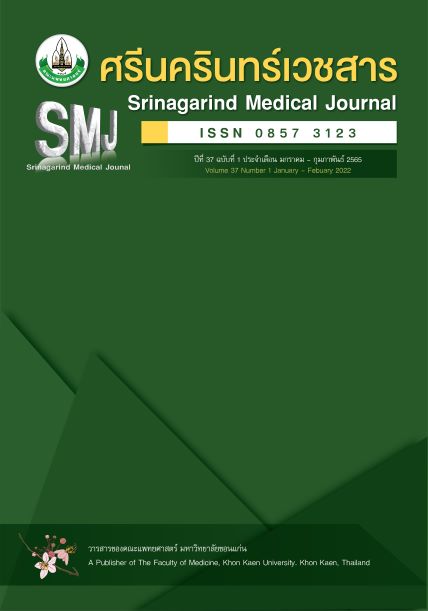อุบัติการณ์การตอบสนองทางพยาธิวิทยาแบบสมบูรณ์ในผู้ป่วยมะเร็งลำไส้ตรงที่ได้รับยาเคมีบำบัดร่วมกับ การฉายรังสีในโรงพยาบาลวชิรพยาบาล
Abstract
Incidence of Pathological Complete Response after Neoadjuvant Treatment in Current Vajira Hospital Rectal Cancer Practice
หลักการและวัตถุประสงค์: มะเร็งลำไส้ใหญ่และลำไส้ตรง เป็นมะเร็งที่พบได้มากที่สุดเป็นอันดับสามทั่วโลก การรักษาที่ได้รับการยอมรับในปัจจุบันในผู้ป่วย locally advanced rectal cancer คือการให้ ยาเคมีบำบัดร่วมกับการฉายรังสี (concurrent chemoradiation therapy; CCRT) ตามด้วยการผ่าตัด total mesorectal excision (TME) ซึ่งผลการตอบสนองต่อ CCRT ในแต่ละงานวิจัยมีความแตกต่างกันอย่างมาก และมีผู้ป่วยประมาณร้อยละ15-30 ที่มีการตอบสนองทางพยาธิวิทยาแบบสมบูรณ์ (pathological complete response; pCR) โดยงานวิจัยนี้จึงมีเป้าหมายที่จะศึกษาเกี่ยวกับอัตราการตอบสนองทางพยาธิวิทยาแบบสมบูรณ์ (pCR rate) และปัจจัยที่มีผลต่อการตอบสนองทางพยาธิแบบสมบูรณ์ ในผู้ป่วยมะเร็งลำไส้ตรงที่ได้รับยาเคมีบำบัด ร่วมกับการฉายรังสีในประเทศไทย
วิธีการศึกษา: เป็นการศึกษาแบบย้อนหลัง (retrospective review of a prospectively collected database) โดยศึกษา ผู้ป่วยที่ได้รับการวินิจฉัยว่าเป็นมะเร็งลำไส้ตรง ระยะที่ 2-3 ที่มี cT3-4, N0 หรือ any cT, cN1-2 เท่านั้น และผู้ป่วยต้องได้รับการรักษาด้วยการให้เคมีบำบัดร่วมกับฉายรังสีก่อนการผ่าตัด (neoadjuvant CCRT) ในช่วงปี_พ.ศ. 2557-2563
ผลการศึกษา: ผู้ป่วยมะเร็งลำไส้ตรง ระหว่างปีพ.ศ. 2557-2563 ทั้งสิ้น 234 ราย มีผู้ป่วย 101 ราย (ร้อยละ 43.1)ที่ได้รับ neoadjuvant CCRT โดยมีผู้ป่วยชาย 68 ราย (ร้อยละ 67.3) อายุเฉลี่ย 58.5±11.5 ปี ตำแหน่งก้อน ที่พบมาก ที่สุดคือ lower rectum 60 ราย (ร้อยละ 59.4) มีclinical T staging เป็น cT3 76 ราย (ร้อยละ 75.2)และ clinical N staging เป็น cN1-2 54 ราย (ร้อยละ 53.5) มีผู้ป่วยทั้งสิ้น 14 ราย (ร้อยละ 13.9) ที่มีการตอบสนองทางพยาธิวิทยาแบบ pCR เมื่อคำนวณ univariate analysis และ multivariate analysis แล้วพบว่าCEA>2.5, cN1-2 และ การให้ยา capecitabine เป็น radiosensitizing agent มีผลต่อการเกิด pCR โดยมี OR 0.23 P = 0.04 (95%CI 0.59-0.93), OR 0.15 P = 0.02 (95%CI 0.03-0.79) และ OR 9.89 P = 0.01(95%CI 1.62-60.25)
สรุป: อัตราการตอบสนองทางพยาธิวิทยาแบบ pCR คือ ร้อยละ 13.9 โดยมีปัจจัยที่มีผลต่อ pCR คือ CEA>2.5; OR 0.23, P = 0.04 (95%CI 0.59-0.93), cN1-2 OR 0.15 P = 0.02 (95%CI 0.03-0.79) และการได้รับยา capecitabine เป็น radiosensitizing agent OR 9.89 P = 0.01(95%CI 1.62-60.25)
คำสำคัญ: มะเร็งลำไส้ตรงขั้นสูง, การตอบสนองที่สมบูรณ์ทางพยาธิวิทยา, ปัจจัยพยากรณ์โรค, เคมีบำบัด
Background and Objective: Colorectal cancer is the third most common cancer worldwide. The current standard treatment for locally advanced rectal cancer is neoadjuvant concurrent chemoradiation therapy (CCRT) followed by total mesorectal excision (TME). The responses to CCRT differ significantly in each study, and approximately 15-30% of patients have pathological complete response(pCR). This research aims to investigate the pCR rate and the factors affecting the pCR after neoadjuvant CCRT in rectal cancer.
Method: A retrospective study of locally advanced rectal cancer, diagnosed with cT3-4, N0 or any cT, cN1-2, who underwent neoadjuvant CCRT during 2014-2020.
Results: A total of 234 rectal cancer patients, there were 101 (43.1%) patients treated with neoadjuvant CCRT, with 68 (67.3%) male patients and a mean age of 58.5 years (+/- 11.5). The most common cancer location was the lower rectum, 60 (59.4%). For clinical staging, 76 patients had cT3 (75.2%) and 54 patients had cN1-2 (53.5%). A total of 14 patients (13.9%) had pCR. When univariate analysis and multivariate analysis were calculated, it was found that CEA> 2.5, cN1-2 and capecitabine as a radiosensitizing agent affected pCR with OR 0.23 P = 0.04 (95% CI 0.59-0.93), OR 0.15 P = 0.02 (95% CI 0.03-0.79) and OR 9.89 P = 0.01 (95% CI 1.62-60.25), respectively.
Conclusion: The pCR rate was 13.9%, with factors affecting pCR were CEA> 2.5, cN1-2 and capecitabine as a radiosensitizing agent.
Key words: Locally advanced rectal cancer, pathological complete response, prognostic factor, neoadjuvant concurrent chemoradiation therapy


